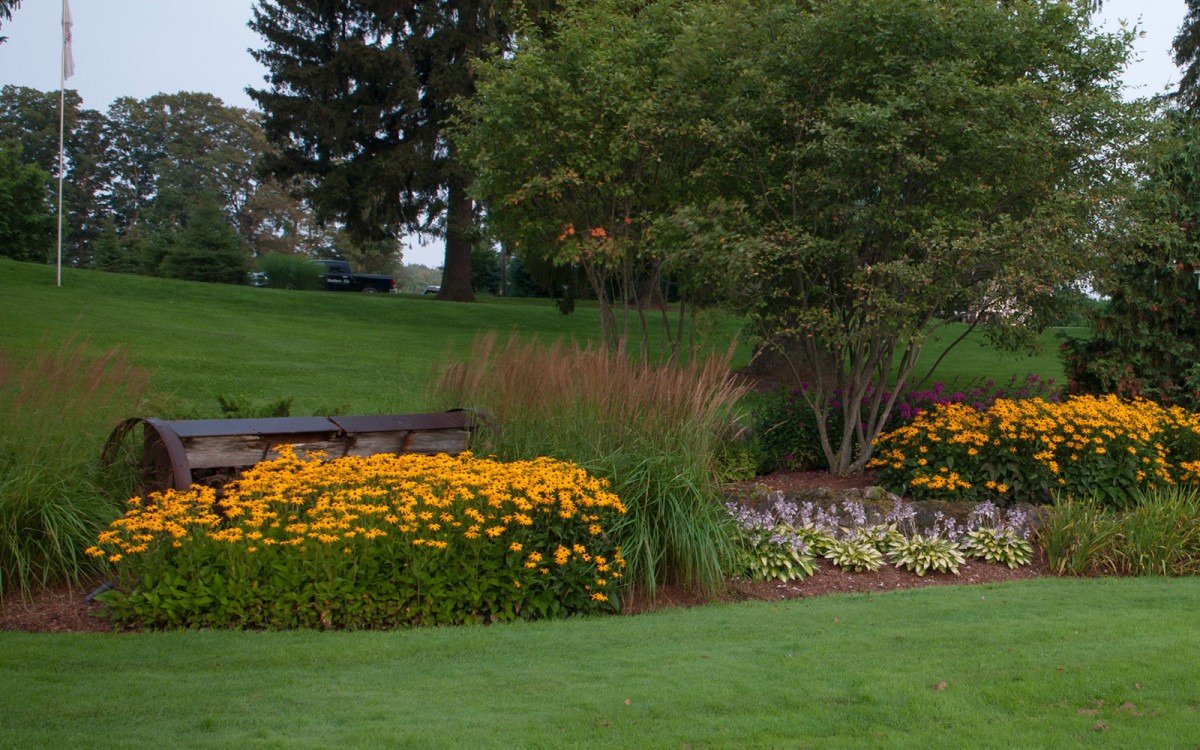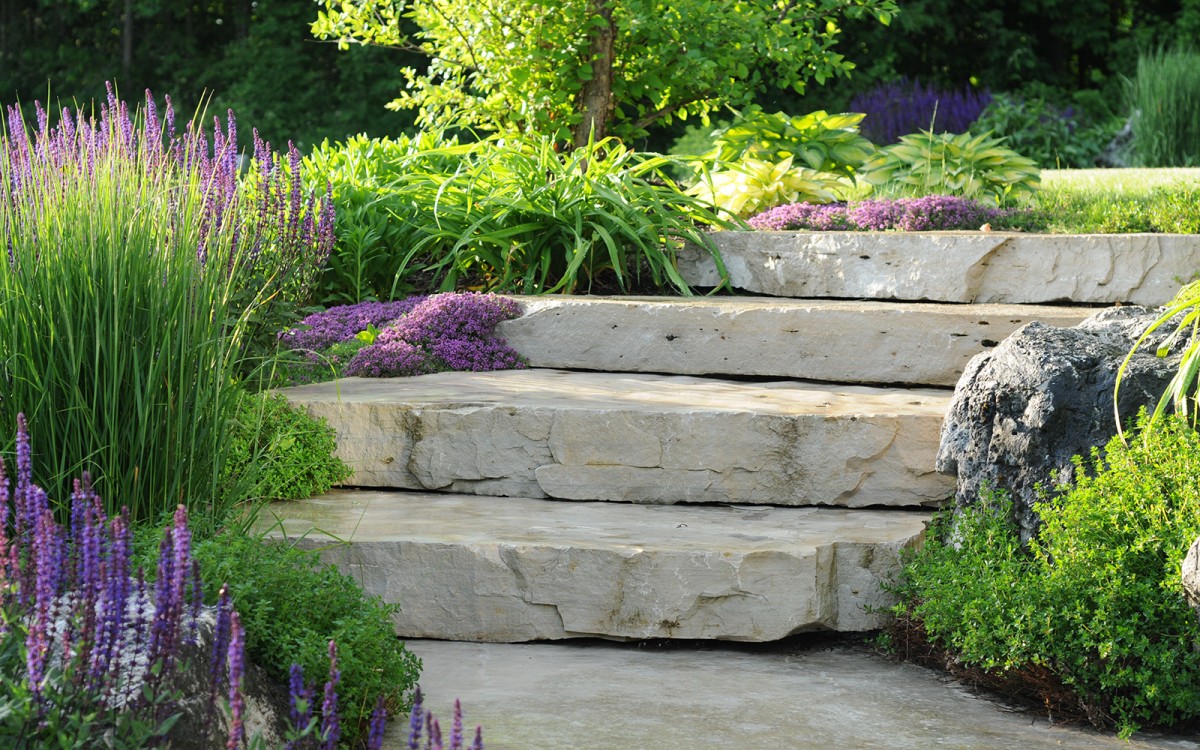The variety of perennial plants available is virtually endless, which makes choosing the right ones to plant a bit more challenging.
Here along the shore of Georgian Bay, we’re limited to plants that can survive our cold winters, rated for hardiness zone 5 or below. But don’t despair… there are plenty of beautiful perennials that thrive in our region.
Before you head off to the garden centre, check out our perennial guide. It’ll tell you what perennials are, how to choose them, and which ones are best for Grey and Bruce counties.
Enjoy!

What are perennials?
Perennials are plants that live for two years or more, dying back in the fall and winter and returning each spring. Most perennials spread readily too, filling out garden spaces and providing more colour each year.
With proper care, perennials will add beauty to your garden for decades. Some just need routine feeding and watering in the summer, with some mulch added to the beds to keep down the weeds and provide winter protection. Others are a bit fussier and need to be deadheaded to encourage new blooms.
Trying to plant an entire garden each year using only annuals is time-consuming and expensive, so perennials should form the foundation of your garden. You just have to plant them once and they’ll reward you with blooms year after year.
How to choose perennials
When choosing perennials for your garden, there are a few factors to consider.
- Sun and shade exposure in your gardens — Watch your garden carefully and take note of how much sun it gets, and when it gets it. Some flowers do best in full sun, while others need some shade to reach their full potential. Shade-loving plants do best if they’re protected from the harsh afternoon sun.
- Your property’s hardiness zone — Hardiness zones are geographic areas, divided by climate, that help determine which plants grow best in any given location. As mentioned above, the hardiness zone for our area is around 5 but could be lower closer to the shore.
- The current structure of your garden beds — If you already have an established garden and are adding to it, take note of which perennials you already have, how tall they’ll be at maturity and when they’ll be blooming. Choose plants that bloom at different times of the year so you’ll always have colour in your garden and choose a variety of sizes to make the garden interesting.
- The availability of flowers — If you’re planning on buying from your local nursery or garden centre, your choices will be limited to what they have in stock. If you want something special you can order online and have them shipped directly to you. Just make sure the plant you’re choosing is right for our area.

What are the best perennials for Grey and Bruce counties?
These are some of our team’s favourite perennials and ones we recommend due to colour, fragrance or just general shape.
- Coneflowers — These hardy, drought-tolerant plants produce showy flowers in a range of colors from pink to purple to white. Best in a sunny location and look beautiful scattered in a meadow.
- Russian sage — This versatile plant has a wispy texture and its flower spikes are covered in tiny blue or lavender blossoms. Even after the flowers are gone, the plant continues to impress with its silver-green foliage and fragrant scent.
- Salvia — A member of the mint family, salvia is a gorgeous plant that blooms for a long period of time and comes in a variety of colours. They’re easy to grow, drought-tolerant, and deer resistant, making them a great choice for garden beds in our area.
- Foamflower — This native perennial boasts masses of pink or white flowers, creating quite a show in spring gardens. It will tolerate complete shade, but is happiest when grown in dappled sunlight. The leaves continue to provide interest long after the blooms have faded.
- Blue false indigo — This large, upright perennial boasts clusters of indigo blue flowers from April through June. It has a mounding habit, and looks great even after the flowers fade. Leave the black seed pods on for winter interest.
- Yarrow “paprika” — Yarrow is a tall perennial known for its ruggedness and ability to tolerate extreme weather conditions, drought and poor soil. “Paprika” is a stunning variety with bright red flowers that fade to light pink and creamy yellow as they age.
- Black-eyed Susans — These bright yellow flowers add a cheerful touch to any garden and are prolific bloomers that are easy to grow and maintain, making them perfect for areas where you need masses of flowers.
- Astilbe — Light and graceful, these shade-loving plants come in many delicate hues. They look almost like ferns with their fine leaves — and their bright flowers mean they’re easy to love, year after year. They look particularly good paired with hosta.

Planting tips for perennials
Proper planting and maintenance are key to ensuring the long-term health and vitality of perennials. Once you’ve selected the plants you’ll add to your garden (based on the hardiness zone and available sunlight), it’s time to start planting!
- Prepare the soil — Before planting, prepare the soil by removing any weeds or debris and loosening the soil to a depth of about 6-8 inches. It’s also a good idea to add some organic matter, such as compost or well-rotted manure to improve drainage and nutrients.
- Plant at the right depth — When planting perennials, be sure to plant them at the same depth they were growing in their nursery container. Planting too deep can cause the plant to rot, while planting too shallow can expose the roots and make the plant more susceptible to drying out.
- Water thoroughly — After planting, water the perennial thoroughly to help settle the soil and give the plant a good start. Be sure to water regularly during the first few weeks after planting to help the plant establish its roots and adjust to its new environment.
- Mulch — Mulch around the base of the plant can help retain moisture, suppress weeds and regulate soil temperature. Be sure to keep the mulch away from the stem of the plant to prevent rot.
To maintain the health and appearance of your plants, it's important to apply suitable fertilizer, deadhead, prune, and divide perennials as needed once they are established.
Need help designing and planting your garden?
Not everyone was born with a green thumb or has the time to garden. That’s why we’re here… our team leverages their love for the region with their horticultural skills to create inspiring outdoor environments that blend naturally into land and shore — and perennials play a large role in all our garden designs.
If you’d like to know more about perennials or would like to meet with us to discuss your garden design, feel free to book a meeting. It’s our mission to shape our rugged landscape in ways that captivate, inspire and bring people closer to nature — one garden at a time!




